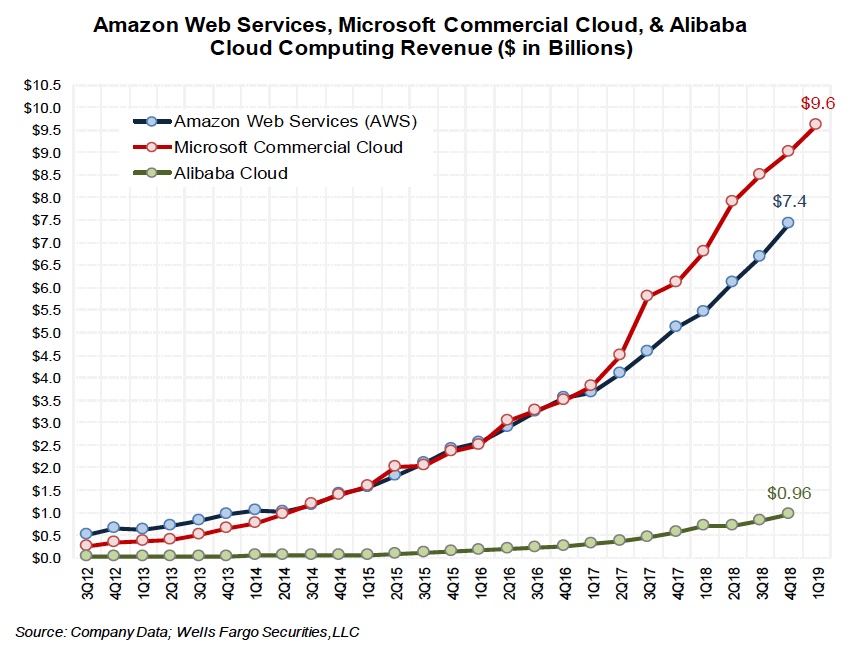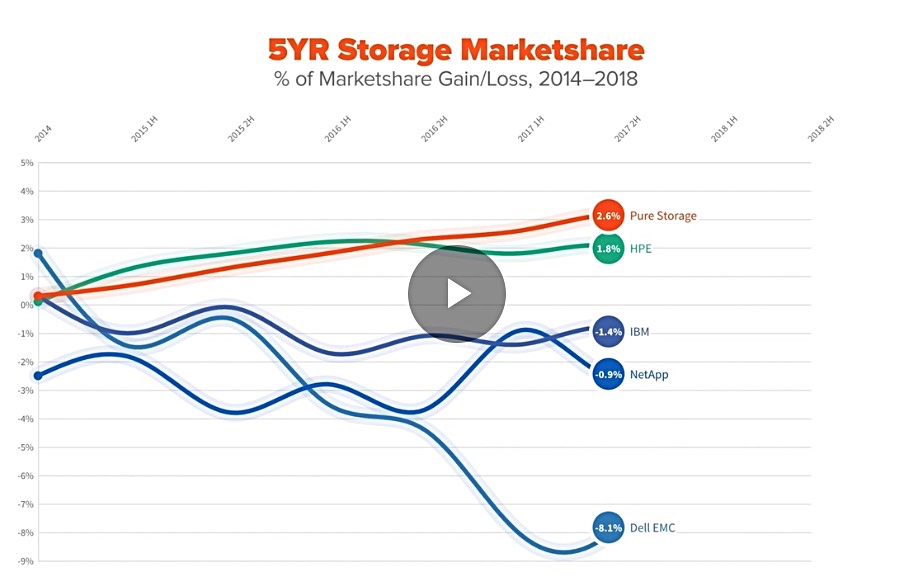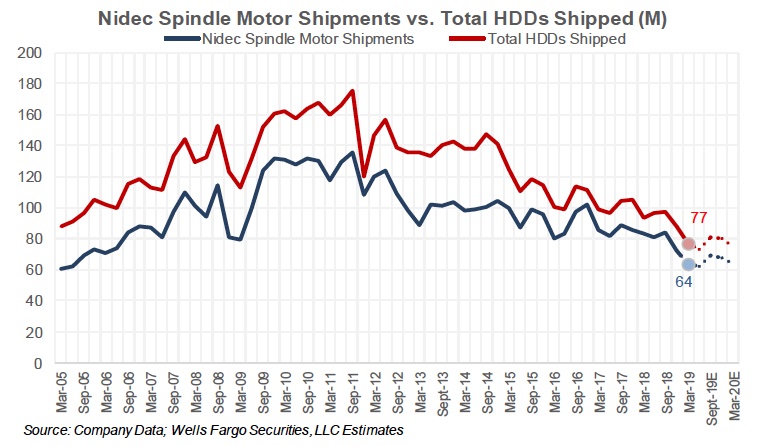Today has been a blockbuster blizzard for enterprise storage news. Blocks & Files will guide you through the day’s events with this handy round-up. Let’s start with Microsoft.
Azure moves in front of AWS
Microsoft is whipping Amazon in commercial cloud computing revenues.
Wells Fargo senior analyst Aaron Rakers has calibrated revenue numbers for Alibaba, Microsoft’s commercial cloud and AWS since 2012’s third quarter, and produced the chart below.

it shows Azure exceeding AWS commercial cloud revenues from 2017 onwards. Not so all-conquering then, Amazon?
Delta Lake cleans up data lakes
Analytics company Databricks said its Delta Lake open source technology cleans up large data sets, also known as data lakes, that are plagued by failed writes, schema mismatches and data inconsistencies through mixing batch and streaming data. Dirty data lakes become cleaned up Delta Lakes.
According to Databricks, developers can code and debug locally on their laptops to develop data pipelines. They can access earlier versions of their data for audits, rollbacks or reproducing machine learning experiments. They will be able to convert existing Parquet, a commonly used data format to store large datasets, to Delta Lakes in-place, avoiding the need for Parquet data reading and re-writing.
Delta Lakes can be plugged into any Apache Spark job as a data source.
Viacom, Edmunds, Riot Games, and McGraw Hill are using the technology. The Delta Lake project can be found at delta.io and is available under the permissive Apache 2.0 license.
Buy Datrium and become backup-free?
Hybrid converged vendor Datrium has gained its ninth US patent, #10,235,044, which concerns deduplication, specifically, converged primary-and-backup deduplication technology. The premise is that if you use its kit you can stop doing backups.
Datrium CEO Tim Page proclaimed: “Our team has developed the world’s only platform that keeps deduplication, compression, erasure coding and data encryption – in transit and at rest – always on, providing the highest levels of performance, while far surpassing industry norms for enterprise security and reliability.”
Datrium said it provides effective deduplication without affection performance of high-IOPS applications. The technology is based on a content-addressed architecture that is said to optimise data at rest, on premises or in the cloud, and data in motion among data centres and the public cloud.
According to Datrium, previous industry approaches to data deduplication has limitations. “They either supported narrow use cases such as streaming sequential backup to disk or required flash, which was cost prohibitive for snapshot retention and data protection.”
Hugo Patterson, chief scientist at Datrium, said: “We are the first to build a system that combines industry-leading performance and scalability for primary workloads, built-in long-term retention of capacity-optimised application snapshots on affordable media, and bandwidth-optimised data mobility.”
Datrium dedupe tech handles primary storage random IO and enables snapshot storage on less expensive media, such as disks and S3 in the cloud, so that multitudes of snapshots can be retained. Hence the claim that it frees enterprises from having to do backups.
Buy Datrium and become backup-free? Could be worth a look from the Total Cost of Ownership point of view.
Hitachi Vantara DPaaS and STaaS
Hitachi V has introduced a Data Protection service and enlarged its storage-as-a-service offering.
Both are managed services with consumption pricing schemes and have SLAs available. The DPaaS scheme backs up data on Hitachi and other suppliers’ arrays. There are four service classes and deployment is within 60 days of purchase. Hitachi V calls this “fast deployment”.
The STaaS offering provides file, block and object storage on-premises or in a third party data centre. It also takes up to 60 days to deploy.
The block and file options are available in two tiers – performance and capacity – and STaaS is available fully or partially managed.
Pure the main storage array market share gainer
Pure Storage has produced 2014-2019 storage array market share numbers showing it has grown its market share the most, followed by HPE. Dell EMC, IBM and NetApp have all lost market share, according to Pure, as its chart below shows.

This comes from a Pure blog and the chart is animated.
Pure gleefully notes: “For the past several years, Dell’s collection of acquired storage assets dropped share faster than any vendor in the business [and] NetApp is celebrating because they lost only a couple of percentage points.”
Pure boasts “a compound annual growth rate (CAGR) above 65 per cent in the last four years (FY15-19). Meanwhile, the Enterprise Storage Market has grown just over 1 per cent in that same time frame.”
This is an astute piece of marketing by the Pure people. However, Gartner’s recent picture of all-flash array vendor shares casts a different light, as you can see below.

Hard times for hard disk drives
Nidec, a maker of disk drive spindle motors, forecasts global hard disk drives shipments at 309 million in 2019, down 18 per cent on 2018. Shipments will fall a further six per cent in 2020 to about 290 million drives.
High-capacity and nearline drives will total 54 million in 2019, up from 41 million in 2017 and 51 million in 2018. This is the growth HDD sector, with 60 million shipments slated for 2020. Due to SSD cannibalisation other HDD categories such as mission-critical, PC, mobile and consumer electronics, are all expected to decline.

Our thanks to Wells Fargo senior analyst Aaron Rakers for sharing the numbers and chart.
Virtual Instruments parades end-to-end NVMe-oF testing
Virtual Instruments (VI) can model and test an end-to-end NVMe-over Fabrics infrastructure and you can see the results at Dell Technologies World, Las Vegas, April 29 – May 2.
Building on its August 2018 reseller deal with SANBlaze and its VirtualLUN tech, VI will show a Dell server talking via a Connectrix switch (OEMed MDS 9100 32Gbit/s FC from Cisco) to a PowerMax array.
VI WorkloadWisdom does the storage workload modelling. SANBlaze VirtualLUN software will generate a storage IO load to exercise the PowerMax array. Cisco SAN Analytics and SAN Telemetry streaming will produce switch data to be collected by VI’s VirtualWisdom infrastructure performance management software.
That software will also receive telemetry data from the PowerMax array, and it can then provide end-to-end performance reporting on the set-up. It means that a customer could have a potential NVMe-oF deployment modelled and tested before pulling the trigger on buying the kit.
WANdisco revenues wilt in cloud shift
Replicator WANdisco reported revenues of $17m for calendar 2018, down 10.2 per cent on 2017’s $19.6m. The operating loss worsened from -$9.7m in 2017 to to $22.1m in 2018.
The first 2019 quarter looks better with $4m in revenues, up 38 per cent year on year.
WANdisco is shifting to cloud subscription sales, and will take a perpetual license revenue hit while it is negotiating the switch-over.
Chairman and CEO Dave Richards said, in a statement: “We have significantly extended our relationship with Microsoft, gaining co-sell status that allows our WANdisco Fusion platform to be sold as a standard offering with Microsoft’s Cloud Solution, Azure.”
He added: “We also have begun to see a significant structural shift in the composition of our revenue base, from large, difficult-to-forecast on-premises transactions toward more predictable, annual recurring cloud revenues. We see significant opportunities to expand our addressable market in cloud and as annual recurring revenues increase over time, develop a smoother, increasing revenue profile for our firm.”
Zerto goes into the blue with Azure
Zerto says it’s doing great with Azure and wants to do more.
The company provides DR services in the public cloud and has sold Azure services through a formal co-sell relationship with Microsoft since April 2018. Zerto claimss a 330 per cent increase in co-sell deals from 2017 to 2018. But as it does not proved a base figure for 2017, one can reasonably ignore this boast.
More pertinently, Zerto said it is now a top 10 Microsoft co-sell partner worldwide. The company is working with the Azure Sponsorship program to support Microsoft End of Support (EOS) migrations and roadmap coordination. This year will see Microsoft ending support for Windows Server 2008 and SQL Server 2008.
Zerto said it can assist users with workload migration from dead ended productss. Microsoft doesn’t want to lose these EOS customers and is offering three years’ support to migrate workloads to Azure.
Not to be outdone, Zerto is offering up to $3,000 of Azure credits for assessments, proof of concepts and deployments to current customers, prospects or partners.
In other news Zerto has hired David Macmillan as its VP for the EMEA region. He’s a 35-year IT vet with previous roles at MuleSoft, Jive, Initiate and IBM.
Shorts
Acronis is opening up API access to its Cyber Platform for developer use by ISVs, OEMs, and service providers, with software development kits (SDK) and sample code. New open APIs provide access that was previously available only to Acronis and select integration partners such as ConnectWise, Microsoft and Google.
The company is also prepping an Acronis Total Protect product that merges backup, cybersecurity and system management capabilities.
DriveScale will exhibit its Composable Platform at Dell Technologies World, Las Vegas, April 29 – May 2, using PowerEdge Servers, Ethernet switches, and Dell EMC arrays. It will show its reference architecture.
The company can talk about ATT Xander division company AppNexus, where it composes infrastructure with 1,000s of Dell EMC servers.
Hyperconverged infrastructure supplier Pivot3 is supporting the latest version of Citrix Virtual Desktops. There is a reference architecture you can check out.








